BEEF - Pastrami
Revised on 9-24-2017.
Pastrami is made by smoking a cut of meat after in has been "corned". This can be done to most any cut of meat but beef brisket is used very often. The techniques below use store bought corned beef brisket flats, instead of the fattier points.
TIP: The strength and flavor of the brine or corning liquid used on store-bought corned briskets vary greatly from brand to brand and pre-soaking in water is necessary to insure that the finished product is not too salty. When using an unfamiliar brand, play it safe and use longer soaking times. I rarely soak longer than 8 hours, but some "salt-sensitive" readers report good luck with an overnight soak-out. The flavor will mellow slightly.
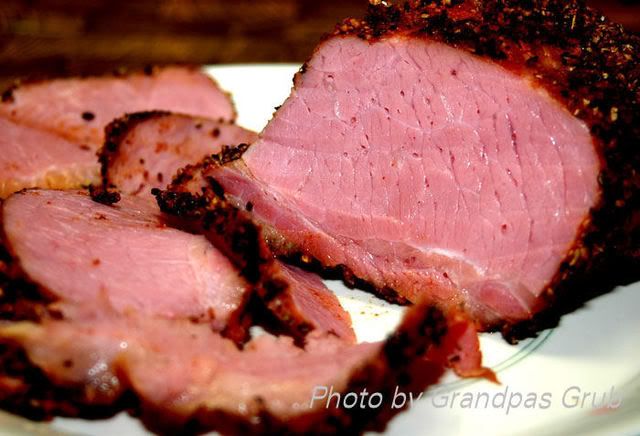
Several of the folks on The Big Green Egg forum helped me fine tune this pastrami recipe which uses a store-bought corned beef brisket flat. Grandpas Grub, a BGE forum regular allowed me to post this great photograph of his wet pastrami.
After about 10 years of testing, my current favorite combinations of the variables I will be discussing below are using a Grobbel's brand corned brisket flat (my Sam's Club carries them), 4 to 6 hours of soak time and Method # 4 Pressure finish. For the other methods, I use a longer soak times. Following the soak-out the corned briskets are seasoned and get an overnight rest in the fridge, then smoked with your favorite flavor wood until the internal is 150° at which time they are probed for tenderness and the cook time is adjusted from there. It’s a good idea to monitor the internal temperature, but probing for tenderness is more accurate.
RUB:
(this recipe makes enough rub to season several corned briskets, any leftover can be stored in a zipper baggie in the freezer for several months)
4 tablespoons freshly ground black pepper (more if you like it peppery)
1 teaspoon ground coriander
1 teaspoon granulated garlic powder
1 teaspoon onion powder
2 teaspoons Canadian/Montreal Steak seasoning
1/2 teaspoon thyme, dried
1 teaspoon paprika
Combine all ingredients and mix thoroughly.
PREPARATION
I try to find a corned brisket in the 4 pound range. Discard the little package of seasoning and drain the juice from the package and rinse. Soak brisket(s) in cool water in a plastic container or zipper top bag, in the fridge, at least 4 hours and up to 24 hours if you are salt sensitive, changing water at least two or three times as this helps to extract some of the injected brining solution. Dry the brisket, trim loose fat and any fat that is spongy, then lightly score the fat side with a knife to mark the grain direction, apply a layer of rub to all sides. Set the seasoned brisket in the refrigerator overnight in a pan, on a rack. On cooking day, set the brisket out for up to an hour, then re-season any thin or disturbed spots with a sprinkle of rub.
TIP - GRAIN DIRECTION: Marking the grain direction is critical. An alternate method is to make a cut on a corner, or a "V" notch can be used to indicate grain direction.
TENDERNESS NOTE: Corning is a form of curing and the process imparts some changes to the meat.... color, texture, flavor etc. So when cooking or smoking, it does not perform like raw non-cured meat. Think of the differences between a ham and a fresh pork roast and you will understand what I mean. A corned round roast is easier to cook tender than a corned brisket, as is a corned London broil. A corned beef plate (the meat behind the brisket and below the ribs) is a bit more tender than a brisket. In some cases a corned brisket point is easier to cook tender than a corned brisket flat (although the flat has less fat and lends itself to slicing). The famous Katz's Deli in New York uses corned beef plate, also known as short plate.
FINISHING METHODS: Using a finishing method (following smoking) will allow you to dial-in some characteristics you may find more desirable, such as tenderness and moistness. Finishing methods are discussed below and are foil finish, braise finish, pressure finish, and steam finish.
FINISH TEMP NOTE: The most important part of the instructions for the final internal temperature or "finish temp" on my site are "Cook until the internal temperature is at least 165° to 170° and the pastrami is tender. Rest before serving. Remember to slice against the grain". So.....monitor the internal, and also confirm the tenderness with a toothpick. There are several corned products, ... corned round roasts and corned briskets are the most common. When cooking/smoking a corned brisket, you may need to go to 180°, 190° or even 200° internal, but remember you are usually slicing pastrami thin, which helps with the tenderness. Also different brands of corned briskets can be different, once you find a brand you like stick with it.
COOKING METHOD #1 Pastrami
Cook with an indirect set up using barbecue temps of 220° to 250° (grate temperature) until tender (see note above). Use a gentle amount of smoke, pecan is my favorite. Loosely wrap in foil then over-wrap with newspaper and place in a preheated cooler and rest for 1 hour. Slice thin, against the grain. Serve warm, with mustard, rye bread and pickles.
COOKING METHOD #2 Wet Pastrami - Foil Finish
Set up you cooker as described in method #1, using the same cooking temperatures and flavor wood. When the pastrami reaches around 150° internal temperature, (usually 4 to 5 hours), remove from the cooker, wrap in a double layer of foil (adding up to 1/4 cup of water, beer or chicken broth is optional), then return to the cooker (or use your oven). The foil will allow the pastrami to steam/braise during the remainder of the cook. Cook until tender (see note above). Rest before serving. Remember to slice against the grain. Wet pastrami can be served on sandwiches or as a main meat with cabbage and potatoes on the side. Foil time will be 1.5 to 2 hours, but always confirm tenderness rather than depending on time alone.
TIP #1: As an option to braising in foil, you can do this step in a Dutch oven, an oven pan with a cover. These may require more liquid than when using a foil pouch.
COOKING METHOD # 3 Wet Pastrami - Steam Finish.
A steam finish is very common in deli's. The smoked pastrami roasts are moved to a steamer pot for tenderizing, and the meat is usually sliced to order, with the roasts being returned to the steamer for holding in between orders. For home use, you can use a pasta pot, tamale pot or anything with a steamer insert or rack to keep the roast off the bottom of the pot.
COOKING METHOD #4 Wet Pastrami - Pressure Finish.
I use a "pressure finish" in a pressure cooker for my wet pastrami and really like the results. Currently, this is my favorite finishing method. It is similar to olde fashioned steamed pastrami I've had in deli's. Following smoking to 150° internal, add 2 to 3 cups of water or a weak beef broth (this amount can be adjusted up or down to match the size of your pressure cooker) to your pressure cooker and cook the pastrami for 25-40 minutes* (see notes below). (You can also use the rack that came with your pressure cooker to keep the pastrami from sitting in too much liquid).
Following cooking, remove the cooker from the burner and let the pressure fall on it's own. This is called "natural release". I have been using corned briskets in the 4 pound range. Smaller ones may require less time under pressure. The bark will be softened, but holds up well and sets-up once chilled.
*A note on pressure cookers, pressure times and personal preference....Read the instructions that came with your pressure cooker for guidelines on use, amount of liquid and processing time. Generally all pressure cooker recipes are based on a cooker which operates at 15 psi (pounds per square inch), however there are several brands or models which operate from 8 psi and up. Consult your owners manual to determine the pressure rating of your cooker. If it operates at a pressure lower than 15 psi, you will have to add time for processing. Altitude also plays a role in your processing time, but the rule is an easy one: For every 1000 ft above 2000 ft elevation, increase the cooking time by 5%. The last variable is personal preference. Keep good notes and try to keep the weight constant from batch to batch, adjust your processing times up or down as you see fit. One thing to remember, if after processing your pastrami is not quite tender enough (using the fork or an ice pick to check tenderness while it's still in the pressure cooker) just put the lid back on and run it back up to pressure and process 5 more minutes.
I live at 5400' above sea level. I process a 4 pound pastrami 35 to 40 minutes at 15 psi. If I want a very tender product, I'll go 45 or 50 minutes. I used a 45 minute pressure time on the pastrami below and you can see it was sliced while hot and is very tender.
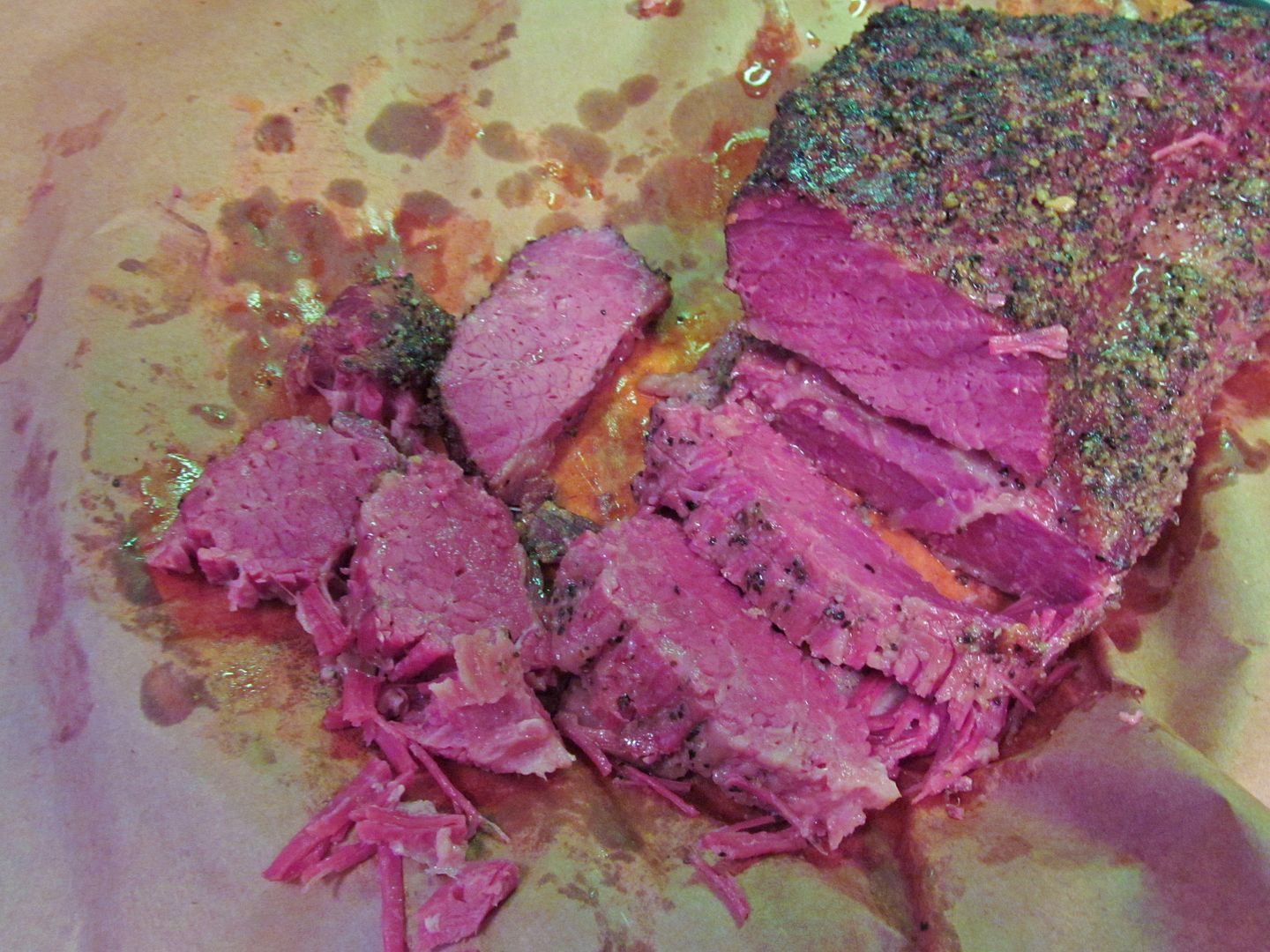
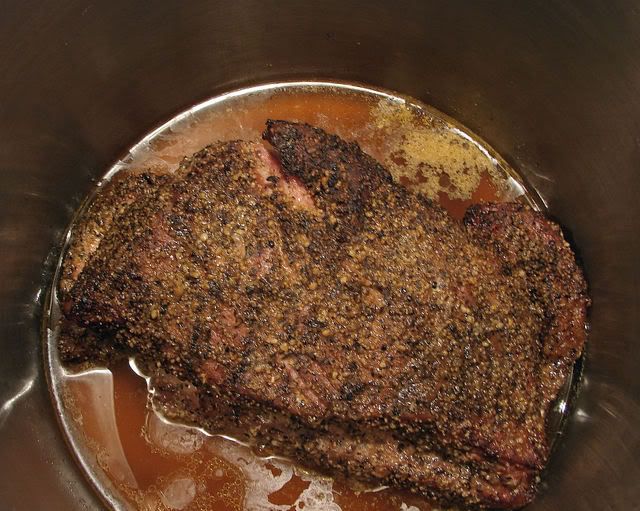
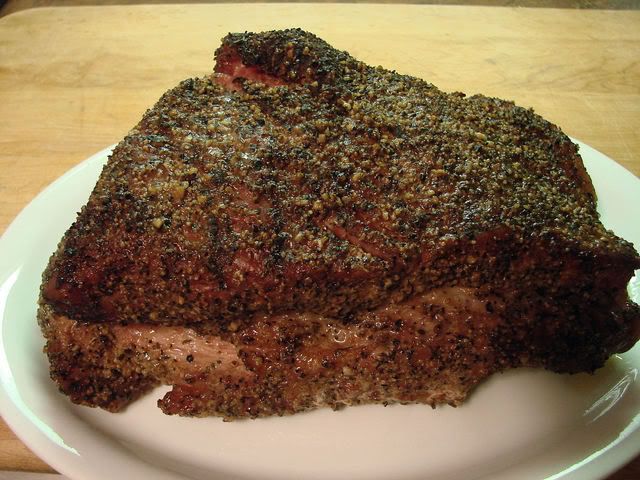
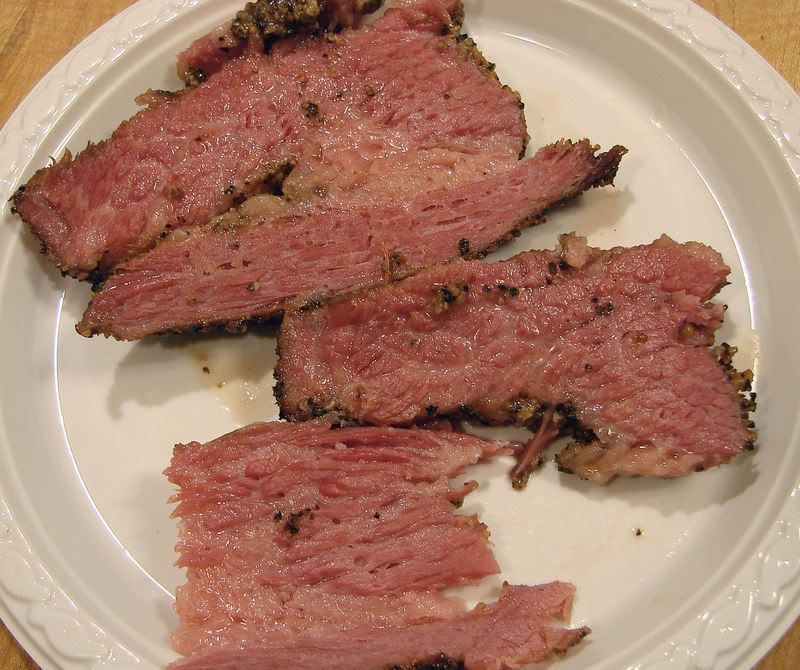
~~~~~~~~~~~~~~~~~~~~~~~~~~~~~~~~~~~~~~~~~~~~~~~~~~~~~~~~~~~~~~~~~~~~~~~~~~~~~~~~
Here is a Guest Pit Boss technique that comes from Bobberqer. It also uses store-bought corned briskets:
Pre-soak the brisket(s) for 48 hours in cool water (iced to maintain the temperature below 40°, or kept in the refrigerator in a bucket or zipper bag). Add some roughly cubed, raw potatoes to the water, (appox 2 pounds) to help soak up some of the salts that are drawn out of the brisket. Change the water, and potatoes, every 12 hours. Some of the water from the last soak may be saved and used for boiling cabbage.
At the end of the soaking time discard the potatoes, remove the brisket, and let dry. Then apply the following rub, reserving some for another coating before slicing. Wrap brisket in plastic, then refrigerate overnight.
RUB:
4 parts ground peppercorns
4 parts ground coriander seeds
2 parts Turbinado sugar
2 parts ground Juniper berries
1 part ground onion powder
1 part thyme, ground
1 part paprika
1 part ground garlic powder
1 part ground ginger
1/2 part ground cloves
1/2 part ground nutmeg
On cooking day bring brisket to room temperature, then cook with an indirect set up at 275° (grate temperature) until the internal temperature is 180°. Allow about 1 hour per pound for cooking.
During the last 1/2 hour of the cook, glaze the brisket with one of these two concoctions, then rest about 1/2 hour, re-apply rub liberally, then slice against the grain and serve. This is Heaven.
Glaze # 1
1 cup honey
1 cup maple syrup
1/2 tablespoon cinnamon
1/4 cup confectioner’s sugar
Heat liquids gently, over low heat, until warm to touch. Then add cinnamon, and slowly mix in confectioner’s sugar until thoroughly mixed. Take off heat, set aside until needed, Use to glaze meat while on cooker. Reserve some glaze to serve on the side at the table.
Glaze # 2
1-16 oz package fresh cranberries
1 cup sugar, (Turbinado sugar is a nice touch)
1 jar, approximately, 10 oz. of Red Currant Jam
1- 8 oz container of Honey Mustard
Put cranberries in a 3-4 Qt pot on low, and add sugar... stir occasionally, cook until cranberries start to "pop". Add Red Currant Jam, and Honey Mustard and let simmer for approximately 10 minutes, stirring a few times during the process. Take off heat, set aside until needed use to glaze meat while on cooker. Reserve some glaze to serve on the side at the table.
Cooks Notes:
I'm of an Irish, "off the boat” heritage, and have been tweaking this recipe since the mid 70's. Only in the last 4 years have I hit what I call "Corn Beef Nirvana".
Bobberqer

No comments:
Post a Comment